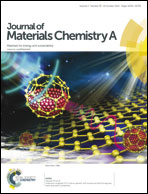DTBDT-TTPD: a new dithienobenzodithiophene-based small molecule for use in efficient photovoltaic devices†
Abstract
We designed and synthesized a dithienobenzodithiophene (DTBDT)-based molecule with a planar molecular geometry, DTBDT-TTPD, for the fabrication of solution-processable organic solar cells (OSCs). DTBDT-TTPD exhibited both a low optical band gap of 1.88 eV and a low-lying highest occupied molecular orbital (HOMO) energy level of −5.61 eV, indicating that DTBDT-TTPD is a promising electron donor for use in OSCs. OSCs prepared with DTBDT-TTPD as the electron donor and [6,6]-phenyl-C71-butyric acid methyl ester (PC71BM) as the electron acceptor were fabricated. An optimized power conversion efficiency of 4.98% with a high short circuit current of 10.6 mA cm−2 was achieved after finely tuning the morphology through an annealing step. These results indicate that DTBDT-TTPD is an effective compound for producing very promising characteristics in small-molecule solar cell devices.


 Please wait while we load your content...
Please wait while we load your content...